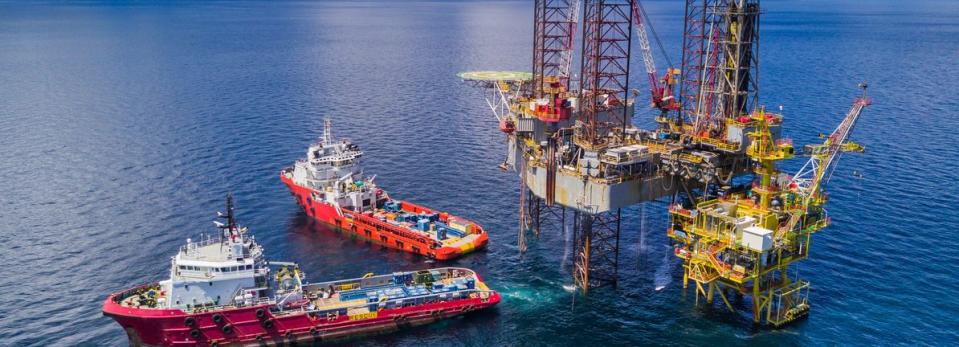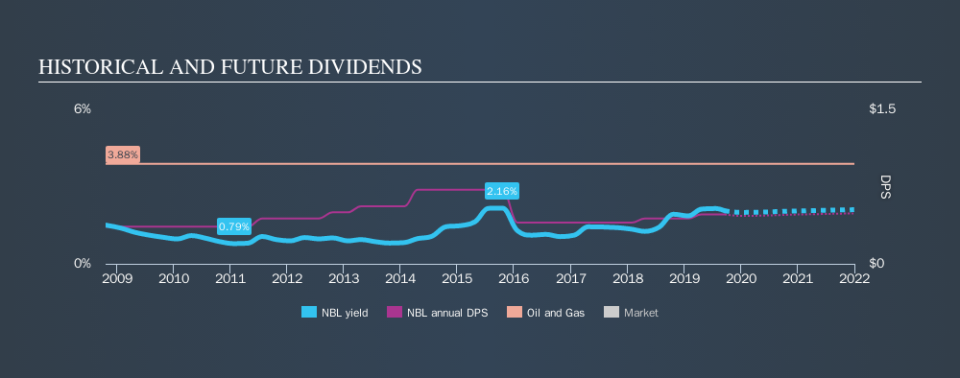Noble Energy, Inc. (NYSE:NBL) Investors Should Think About This Before Buying It For Its Dividend

Today we'll take a closer look at Noble Energy, Inc. (NYSE:NBL) from a dividend investor's perspective. Owning a strong business and reinvesting the dividends is widely seen as an attractive way of growing your wealth. Yet sometimes, investors buy a stock for its dividend and lose money because the share price falls by more than they earned in dividend payments.
While Noble Energy's 2.1% dividend yield is not the highest, we think its lengthy payment history is quite interesting. The company also bought back stock equivalent to around 0.6% of market capitalisation this year. Some simple research can reduce the risk of buying Noble Energy for its dividend - read on to learn more.
Click the interactive chart for our full dividend analysis
Payout ratios
Companies (usually) pay dividends out of their earnings. If a company is paying more than it earns, the dividend might have to be cut. As a result, we should always investigate whether a company can afford its dividend, measured as a percentage of a company's net income after tax. Although it reported a loss over the past 12 months, Noble Energy currently pays a dividend. When a company is loss-making, we next need to check to see if its cash flows can support the dividend.
Unfortunately, while Noble Energy pays a dividend, it also reported negative free cash flow last year. While there may be a good reason for this, it's not ideal from a dividend perspective.
Is Noble Energy's Balance Sheet Risky?
Given Noble Energy is paying a dividend but reported a loss over the past year, we need to check its balance sheet for signs of financial distress. A quick check of its financial situation can be done with two ratios: net debt divided by EBITDA (earnings before interest, tax, depreciation and amortisation), and net interest cover. Net debt to EBITDA measures total debt load relative to company earnings (lower = less debt), while net interest cover measures the ability to pay interest on the debt (higher = greater ability to pay interest costs). With net debt of 2.30 times its EBITDA, Noble Energy's debt burden is within a normal range for most listed companies.
We calculated its interest cover by measuring its earnings before interest and tax (EBIT), and dividing this by the company's net interest expense. With EBIT of 3.16 times its interest expense, Noble Energy's interest cover is starting to look a bit thin.
Consider getting our latest analysis on Noble Energy's financial position here.
Dividend Volatility
From the perspective of an income investor who wants to earn dividends for many years, there is not much point buying a stock if its dividend is regularly cut or is not reliable. For the purpose of this article, we only scrutinise the last decade of Noble Energy's dividend payments. Its dividend payments have fallen by 20% or more on at least one occasion over the past ten years. During the past ten-year period, the first annual payment was US$0.36 in 2009, compared to US$0.48 last year. This works out to be a compound annual growth rate (CAGR) of approximately 2.9% a year over that time. The growth in dividends has not been linear, but the CAGR is a decent approximation of the rate of change over this time frame.
It's good to see some dividend growth, but the dividend has been cut at least once, and the size of the cut would eliminate most of the growth, anyway. We're not that enthused by this.
Dividend Growth Potential
With a relatively unstable dividend, it's even more important to see if earnings per share (EPS) are growing. Why take the risk of a dividend getting cut, unless there's a good chance of bigger dividends in future? Noble Energy's earnings per share have shrunk at 14% a year over the past five years. With this kind of significant decline, we always wonder what has changed in the business. Dividends are about stability, and Noble Energy's earnings per share, which support the dividend, have been anything but stable.
Conclusion
When we look at a dividend stock, we need to form a judgement on whether the dividend will grow, if the company is able to maintain it in a wide range of economic circumstances, and if the dividend payout is sustainable. Noble Energy's dividend is not well covered by free cash flow, plus it paid a dividend while being unprofitable. Earnings per share have been falling, and the company has cut its dividend at least once in the past. From a dividend perspective, this is a cause for concern. There are a few too many issues for us to get comfortable with Noble Energy from a dividend perspective. Businesses can change, but we would struggle to identify why an investor should rely on this stock for their income.
Without at least some growth in earnings per share over time, the dividend will eventually come under pressure either from costs or inflation. See if the 17 analysts are forecasting a turnaround in our free collection of analyst estimates here.
Looking for more high-yielding dividend ideas? Try our curated list of dividend stocks with a yield above 3%.
We aim to bring you long-term focused research analysis driven by fundamental data. Note that our analysis may not factor in the latest price-sensitive company announcements or qualitative material.
If you spot an error that warrants correction, please contact the editor at editorial-team@simplywallst.com. This article by Simply Wall St is general in nature. It does not constitute a recommendation to buy or sell any stock, and does not take account of your objectives, or your financial situation. Simply Wall St has no position in the stocks mentioned. Thank you for reading.

 Yahoo Finance
Yahoo Finance 